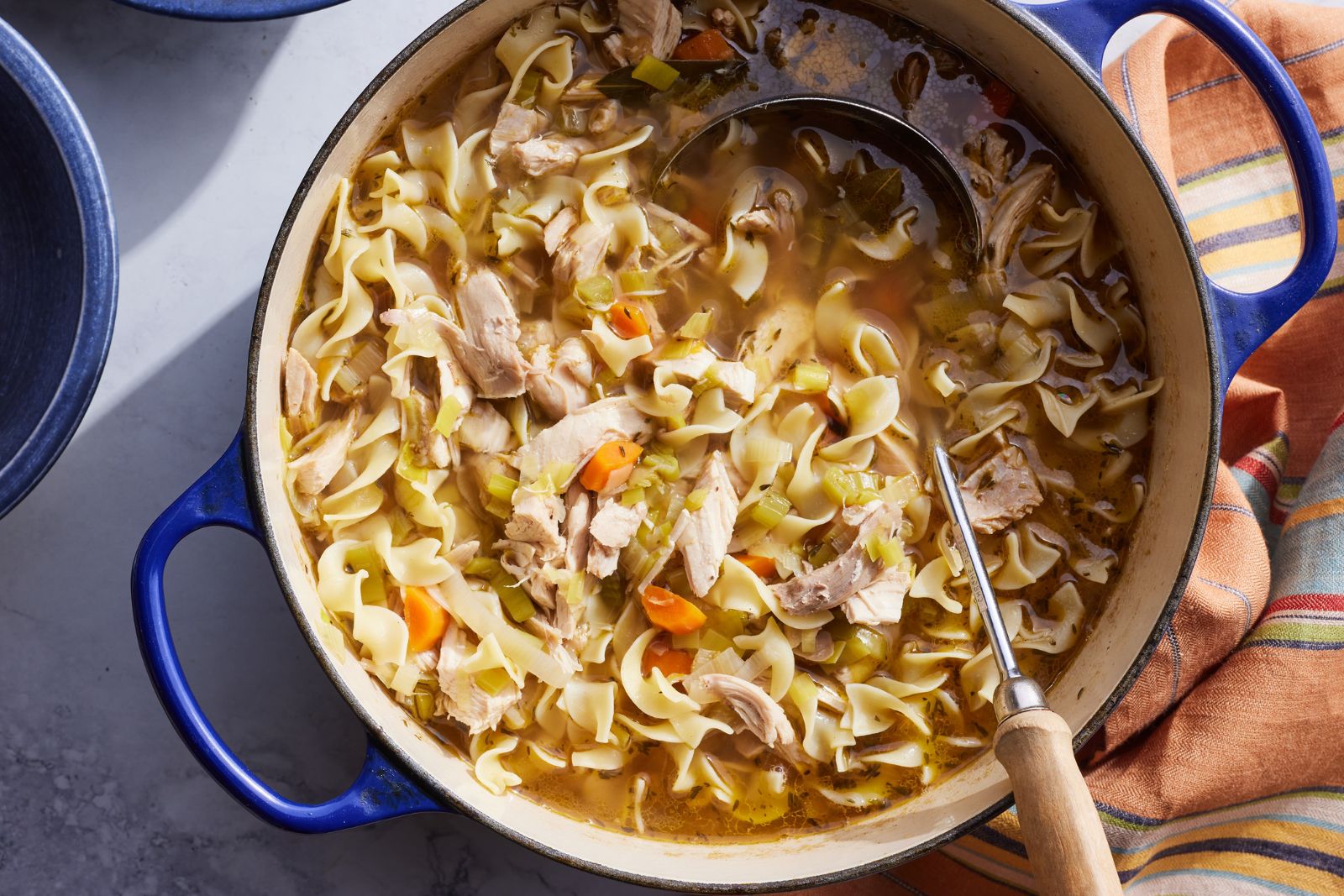
Turkey soup is a delicious and comforting dish that many people enjoy, especially during the colder months or after a holiday feast. Whether you’ve made a large batch of turkey soup and want to save some for later or have leftover turkey soup that you don’t want to go to waste, freezing it is an excellent option. Freezing turkey soup properly will help maintain its flavors and textures, allowing you to savor its warmth and taste whenever you desire. This article will present a step-by-step guide on how to freeze turkey soup to ensure it stays fresh and enjoyable for future meals.
Here’s a comprehensive guide on freezing turkey soup:
Step 1: Allow the soup to cool
Allowing the turkey soup to cool down to room temperature before freezing is a crucial step in the process. When hot food is placed directly into the freezer, it can create an unfavorable environment that may compromise the quality of both the soup itself and other items stored in the freezer.
Firstly, placing hot soup in the freezer can raise the internal temperature of the freezer. This sudden temperature increase can affect the other frozen items in the freezer, causing them to partially thaw and then refreeze once the hot soup cools down. This cycle of thawing and refreezing can lead to the formation of ice crystals and affect the texture and taste of other foods, potentially resulting in freezer burn.
Secondly, rapid cooling can impact the quality of the turkey soup. When hot food is cooled too quickly, it may not evenly distribute the temperature throughout the soup, leaving some parts warmer than others. This uneven cooling can promote bacterial growth in certain areas, making the soup more susceptible to spoilage and foodborne illnesses.
By allowing the turkey soup to cool to room temperature before freezing, you give it time to evenly distribute the temperature throughout the liquid. This gradual cooling process helps preserve the flavors and textures of the soup. Additionally, it reduces the risk of bacterial growth and ensures that the soup remains safe to eat when thawed and reheated.
To facilitate the cooling process, you can place the pot of hot turkey soup in a sink or large container filled with cold water. Stir the soup occasionally to help it cool down faster. Once the soup has reached room temperature, you can proceed with the remaining steps of the freezing process, such as portioning it into containers, labeling, and placing it in the freezer.
Step 2: Choose the right containers
When it comes to freezing turkey soup, selecting the appropriate containers is essential to maintain its quality and prevent any potential issues during the freezing and thawing processes. There are several options available for freezing soup, each with its advantages and considerations.
Airtight containers:
Airtight containers, such as plastic or glass containers with secure lids, are a popular choice for freezing turkey soup. These containers create a tight seal that helps to keep the soup fresh and prevent any leakage or spills in the freezer. They are durable and reusable, making them a cost-effective option in the long run. Additionally, airtight containers come in various sizes, allowing you to portion the soup according to your needs, whether it’s single servings or family-sized portions.
Freezer-safe resealable bags:
Resealable plastic bags designed for freezer use are another convenient option for freezing turkey soup. These bags are space-saving, as they can be laid flat to freeze, and they are easily stackable. When using resealable bags, it’s essential to remove excess air before sealing them to minimize the risk of freezer burn. Double-bagging can provide extra protection against potential leaks.
Glass jars with adequate headspace:
Using glass jars with sufficient headspace is an eco-friendly and visually appealing way to freeze turkey soup. Ensure that the jars you choose are specifically designed for freezing, as regular glass jars may crack or shatter in the freezer due to the liquid expanding as it freezes. Leaving enough headspace (empty space at the top of the jar) is crucial because liquids expand as they freeze, and insufficient headspace can cause the jar to break.
Regardless of the container you choose, there are some essential considerations:
- Size: Opt for container sizes that suit your typical serving needs. Freezing in smaller portions allows for easier defrosting and reduces the risk of wastage.
- Material: Ensure that the containers or bags you use are labeled as freezer-safe. Regular storage containers or bags may not withstand the low temperatures in the freezer, leading to cracks or leaks.
- Labeling: Always label each container or bag with the contents and the date of freezing. This information will help you keep track of the soup’s storage time and make it easy to identify the type of soup you have when searching through the freezer.
Step 3: Portion the soup
When freezing turkey soup, dividing it into smaller portions before freezing offers several advantages and benefits. Properly portioning the soup allows for greater flexibility in terms of thawing and using the soup later on.
- Ease of Thawing: Smaller portions of soup thaw more quickly and evenly compared to freezing the entire batch in one container. This is particularly beneficial if you only need a small amount of soup for a quick meal or if you’re reheating individual servings. It reduces the overall thawing time, making it more convenient when you’re in a hurry or don’t want to thaw more soup than necessary.
- Minimize Waste: Portioning the soup helps to avoid unnecessary waste. Sometimes, you may have leftover soup that you don’t want to thaw and reheat all at once. By freezing in smaller portions, you can defrost only what you need, reducing the risk of leftovers going to waste.
- Preserve Quality: Each time you freeze and thaw soup, there’s a chance that the quality may degrade slightly. By dividing the turkey soup into smaller portions, you reduce the number of times you need to thaw and refreeze the entire batch. This helps maintain the soup’s overall texture, flavor, and nutritional value.
- Convenient for Single Servings: If you live alone or have family members with different schedules, freezing turkey soup in single-serving portions allows each person to enjoy a hot bowl of soup whenever they want, without having to thaw more than they need.
- Adaptable for Different Recipes: Smaller portions give you the freedom to use the frozen soup in various ways. For instance, you can use one portion as a base for a sauce, another for a quick noodle soup, and so on. It provides versatility in how you utilize the frozen turkey soup.
To properly portion the turkey soup, you can use the airtight containers or resealable freezer bags mentioned earlier. Fill each container or bag with the desired amount of soup, leaving a bit of headspace to allow for expansion during freezing. Ensure that the containers or bags are securely sealed to prevent leaks and maintain freshness.
Step 4: Leave room for expansion
When freezing turkey soup, it’s crucial to consider the expansion that occurs during the freezing process. Liquids, including the broth and other components of the soup, expand as they freeze and turn into solid ice. Failing to leave enough space in the containers or bags can lead to potential issues like cracked containers or popped seals, which can compromise the quality of the frozen soup.
Using Containers:
If you’re using airtight containers to freeze turkey soup, make sure to leave some space at the top, commonly referred to as “headspace.” As the soup freezes, it expands, and if there isn’t enough room for this expansion, the pressure can cause the container to crack or the lid to pop open. Leaving adequate headspace allows the soup to expand without causing any damage to the container. For most liquids, leaving about an inch (2.5 cm) of headspace is generally sufficient.
Using Resealable Bags:
For freezer-safe resealable bags, it’s essential to remove excess air before sealing. Air inside the bag can lead to freezer burn, which is caused by moisture in the soup escaping and then crystallizing on the surface of the food. Freezer burn can affect the taste and texture of the soup, making it less enjoyable to eat. To remove excess air, gently press the bag while sealing it to push out as much air as possible. Alternatively, you can use a straw to suck out the remaining air before sealing the bag completely.
Properly managing the expansion during freezing not only prevents damage to the containers or bags but also helps maintain the quality of the turkey soup. By allowing enough space for the soup to expand and removing excess air from resealable bags, you reduce the risk of freezer burn and ice crystal formation. This ensures that when you eventually thaw and reheat the soup, it will taste just as delicious and retain its original texture and flavor.
Step 5: Seal and label
Sealing and labeling the containers or bags of frozen turkey soup is a crucial step in the freezing process. This step serves multiple important purposes and helps you maintain an organized and efficient freezer storage system.
Sealing the Containers or Bags Securely:
Properly sealing the containers or bags ensures that the turkey soup is well-protected from potential contaminants and freezer odors. A secure seal also prevents any leakage or spills in the freezer, which can cause a mess and lead to the cross-contamination of other foods. When using airtight containers, make sure the lids are tightly closed, and for resealable bags, ensure they are completely sealed without any gaps.
Labeling the Containers or Bags:
Labeling each container or bag of turkey soup with its contents and the date of freezing is essential for several reasons:
- Easy Identification: When you have multiple frozen items in your freezer, labeling helps you quickly identify the turkey soup among other dishes. It saves you time and avoids the need to defrost several items to figure out what’s inside.
- Preventing Mix-Ups: By labeling the containers or bags, you reduce the risk of accidentally using the wrong item or misidentifying the contents. This is particularly helpful when you have various soups or dishes stored together.
- Monitoring Storage Time: Knowing the freezing date allows you to keep track of how long the turkey soup has been in the freezer. While frozen soup is safe to eat indefinitely if kept at a constant freezing temperature, labeling the date helps you maintain a rotation system, ensuring you use the oldest soup first and avoid unnecessary waste.
- Quality Control: Turkey soup, like any other frozen food, has an optimal quality window. By knowing the freezing date, you can aim to consume the soup within a reasonable time frame (usually 2 to 3 months) to ensure it retains its best flavor and texture.
When labeling the containers or bags, use a waterproof marker or adhesive labels that won’t smudge or come off during the freezing process. Clearly write the soup’s name and the date of freezing on each container or bag.
Step 6: Freeze promptly
After properly sealing and labeling the containers or bags of turkey soup, it’s essential to transfer them to the freezer promptly. Freezing the soup as soon as possible after preparation or cooling is crucial for preserving its freshness, taste, and overall quality.
- Preserving Freshness: Freshly prepared turkey soup contains all the flavors and nutrients that make it delicious and wholesome. However, over time, the quality of the soup can deteriorate, even if kept in the refrigerator. Freezing the soup promptly halts the natural degradation processes and locks in its freshness at its peak.
- Minimizing Bacterial Growth: Bacteria can multiply at a rapid rate in food if it is kept at room temperature for an extended period. Placing the turkey soup in the freezer promptly prevents the growth of harmful bacteria, reducing the risk of foodborne illnesses.
- Preserving Texture and Taste: The longer soup stays at warmer temperatures, the greater the likelihood that its texture and taste will be affected negatively. By freezing the soup promptly, you preserve its original texture and taste, ensuring it remains as flavorful and enjoyable when reheated.
- Maximizing Space Efficiency: Laying the sealed containers or bags flat initially until they are frozen maximizes space efficiency in the freezer. Flat freezing allows the soup to spread out and create a thin, compact shape, which takes up less space than if it were frozen in an upright position. Once the soup is fully frozen, you can then stack the containers or bags to optimize the use of freezer space.
To freeze the turkey soup promptly and efficiently, place the sealed containers or bags on a flat surface, such as a baking sheet or tray, and make sure they are not touching one another. This prevents the soup from freezing in a lump, making it easier to stack or store them neatly in the freezer once they are fully frozen. Once the soup is solidly frozen, you can rearrange the containers or bags to suit your freezer’s available space.
Step 7: Store the soup
Proper storage of frozen turkey soup is essential to maintain its quality, safety, and taste over an extended period. Following the right storage practices ensures that the soup remains safe to eat and retains its flavors and textures at their best.
Freezer Temperature at 0°F (-18°C) or Below:
Keeping your freezer at a temperature of 0°F (-18°C) or below is crucial for effectively preserving the turkey soup and other frozen foods. At this temperature, the growth of harmful bacteria is significantly slowed down or inhibited, reducing the risk of foodborne illnesses. Lower temperatures also prevent spoilage, maintain the soup’s nutritional value, and ensure it stays fresh for an extended period.
Why Consume Within 2 to 3 Months:
While frozen turkey soup is safe to eat indefinitely when stored at a constant freezing temperature, it’s best to consume it within a reasonable timeframe, typically within 2 to 3 months. This period is recommended to ensure the soup maintains its best quality, taste, and texture. Over time, the freezing process can cause subtle changes in the soup’s characteristics, such as flavor and consistency. Although the soup remains safe to eat beyond this period, its overall quality may gradually decline.
To maximize the quality and taste of the turkey soup, it’s a good practice to follow the “first in, first out” rule. Consume the oldest frozen soup first and avoid keeping it in the freezer for an extended period. If you have multiple containers or bags of frozen soup, rotate them regularly to use the older ones first.
Additionally, proper labeling with the freezing date, as mentioned in the earlier steps, is beneficial for monitoring the storage time and ensuring you enjoy the turkey soup within the recommended period.
Storage Tips:
Here are some additional storage tips to maintain the quality of frozen turkey soup:
- Organize the Freezer: Keep the frozen soup well-organized, placing the oldest items in front for easier access.
- Avoid Temperature Fluctuations: Try to minimize the number of times you open the freezer door, as temperature fluctuations can affect the frozen food’s quality.
- Avoid Refreezing Thawed Soup: Once you thaw turkey soup, it’s best to consume it within a day or two. Refreezing previously thawed soup can further impact its quality and safety.
Other related questions
How do I defrost turkey soup?
To defrost turkey soup, there are three safe methods:
- Refrigerator: Transfer the frozen soup to the refrigerator and allow it to thaw slowly over several hours to a day, depending on the amount.
- Cold Water: Place the sealed soup bag/container in a leak-proof plastic bag and submerge it in cold water, changing the water every 30 minutes until fully thawed.
- Microwave: Use the defrost setting or low power mode on your microwave, ensuring you stir and check the soup frequently to avoid uneven heating.
What’s the best way to reheat frozen turkey soup?
To reheat frozen turkey soup, you can either thaw it overnight in the refrigerator and then heat it on the stovetop or microwave, or reheat it directly from frozen. When reheating, ensure the soup reaches a safe internal temperature (165°F or 74°C) before serving.
Can I refreeze Turkey soup?
It is generally safe to refreeze turkey soup if it has been thawed properly in the refrigerator. However, repeated thawing and refreezing can affect the soup’s quality, leading to potential loss of flavor and texture. To maintain the best quality, it’s recommended to consume the thawed turkey soup within a day or two and avoid refreezing it again.
How do I know if the Turkey soup has gone bad after being frozen?
To determine if frozen turkey soup has gone bad, check for signs of spoilage such as off-smells, unusual colors, or a slimy texture. If the soup has an unpleasant odor, appears discolored, or develops mold, it is likely spoiled and should be discarded. Additionally, if there are any signs of freezer burn or ice crystals on the surface, the soup’s quality may have been compromised, but it may still be safe to eat. Trust your senses and use your best judgment to ensure food safety.
Can I freeze turkey soup with noodles or rice?
Yes, you can freeze turkey soup with noodles or rice. However, it’s important to note that pasta and rice may absorb some of the liquid during freezing, potentially altering the soup’s texture upon thawing. To minimize this, slightly undercook the noodles or rice before adding them to the soup and ensure there is enough broth to compensate for absorption.
Is it safe to freeze turkey soup with dairy ingredients?
While you can freeze turkey soup with dairy ingredients like cream or milk, be aware that dairy can sometimes separate or change in texture when frozen and thawed. For best results, add the dairy after reheating the thawed soup to maintain its creamy consistency.
Can I freeze turkey soup with vegetables?
Yes, you can freeze turkey soup with vegetables. However, some vegetables, like potatoes or zucchini, may have a softer texture after freezing and thawing. For a better result, blanch firmer vegetables before adding them to the soup.
Can I freeze turkey soup that contains bones?
Yes, you can freeze turkey soup that contains bones. Freezing soup with bones can actually enhance the flavor over time. However, it’s essential to remove large bones before freezing to save space and ensure even reheating.
Can I freeze turkey soup with a heavy cream base?
Yes, you can freeze turkey soup with a heavy cream base. Keep in mind that cream-based soups may separate during freezing, but you can whisk the soup while reheating to restore its texture. Avoid freezing soups thickened with flour or cornstarch, as they can become grainy when thawed.








